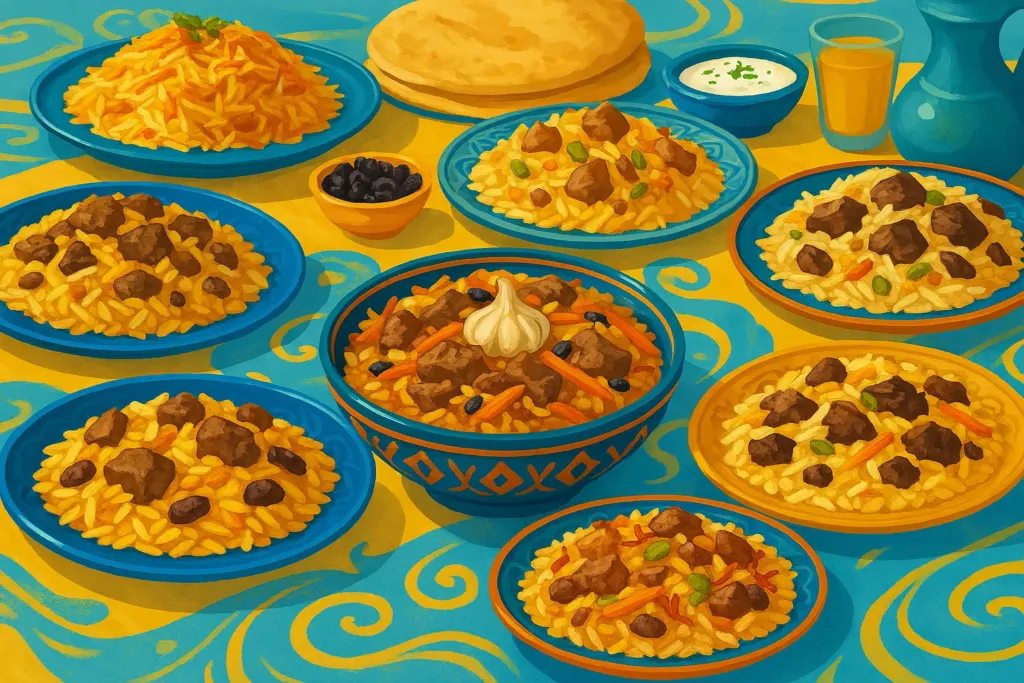Плов — блюдо из риса, мяса, овощей и специй, известное в десятках стран. Его готовят в Средней Азии, на Кавказе, в Турции, Иране, Индии и даже в некоторых европейских странах. У каждой культуры есть свой вариант: в Узбекистане это плотное и сытное блюдо с морковью и бараниной; в Азербайджане — шафрановый плов с сухофруктами; в Турции — пилав; в Индии — острый бириани. Плов часто готовят на праздники, свадьбы, религиозные мероприятия и семейные торжества.
История и культурное значение
История плова насчитывает более тысячи лет. Первые упоминания встречаются в трудах Авиценны, который описывал его как питательное и полезное блюдо. Легенды связывают плов с армиями великих завоевателей, которым требовалось сытное и простое в приготовлении блюдо для больших войск. Плов стал символом гостеприимства: в Узбекистане его подают каждому гостю; В Таджикистане его готовят по пятницам, в Азербайджане его украшают свадебные столы. В 2016 году узбекский и таджикский плов были включены в список нематериального культурного наследия ЮНЕСКО.
Факты и цифры
В мире существует более 200 разновидностей плова. В Узбекистане существует около 60 региональных рецептов. В Самарканде ежегодный фестиваль плова проходит в казанах весом более 500 килограммов. В Азербайджане известны такие разновидности, как шах-плов, фисинджан-плов и сабзи-плов. В Индии в плов бириани может добавляться до 20 видов специй.
Страны и различия в приготовлении плова
Узбекистан — классический узбекский плов с морковью, бараниной, тмином и чесноком, приготовленный в большом казане на открытом огне.
Таджикистан – более насыщенный и жирный на вкус, часто с нутом и изюмом, подается на больших общих блюдах.
Азербайджан – шафрановый рис, мясо и сухофрукты готовятся отдельно и смешиваются перед подачей; популярно на праздниках.
Турция – пилав из риса или булгура, часто с курицей или бараниной, подается в качестве гарнира или основного блюда.
Иран – чело и поло, где рис готовится на пару, часто с шафраном, барбарисом и фисташками.
Индия – бириани с широким ассортиментом специй, иногда с йогуртом, курицей, бараниной или рыбой, часто запечатанный в тесто для сохранения ароматов.
Афганистан – кабульский пулао с морковью, изюмом и миндалем, придающий сладковато-пряный вкус.
Казахстан и Киргизия – плов с говядиной или кониной, иногда с тыквой.
Пакистан – бириани и пулао с более острым профилем, часто с чили и насыщенными соусами.
Похожие истории
В Ташкенте есть Центр плова, где ежедневно готовят тысячи порций для местных жителей и туристов. В старом городе Баку в ресторанах подают плов в медных казанах с шафрановым рисом. В Хайдарабаде, Индия, бириани стал символом города, и туристы специально приезжают, чтобы попробовать его в исторических ресторанах.
Туристические места, связанные с пловом
Ташкентский центр плова — место, где можно увидеть процесс приготовления в огромных казанах и попробовать разные виды этого блюда.
Самаркандский фестиваль плова — ежегодное мероприятие, объединяющее поваров из разных стран.
Старый город Баку — рестораны с традиционным азербайджанским пловом, подаваемым в медных казанах.
Стамбульский рынок — уличный плов с курицей, популярный среди туристов.
Хайдарабад, Индия — рестораны с многовековыми рецептами бириани.
- Daring to Explore Again
- How to Get Around Australia
- Somalia: A Country of Risk and Contrasts — Is It Worth Going?
- Ecuador
- Island
- A quick look at Lucknow: one day in the Uttar Pradesh capital
- Kenya Nchi Yangu Song
- Liechtenstein
- Lithuania
- Falkland Islands
- Indians
- Derbent (Dagestan, Russia)
- And in Africa the mountains are this high
- Kostroma (Russia)
- Germany
- Greece
- Everyone says i’m running away
- Great lakes
- Ratmanov Island
- Reinhard Mey – Über den Wolken

 France
France